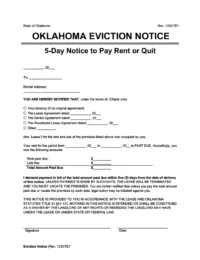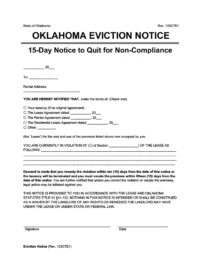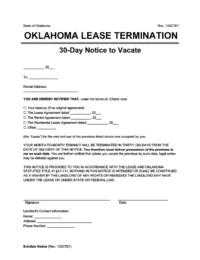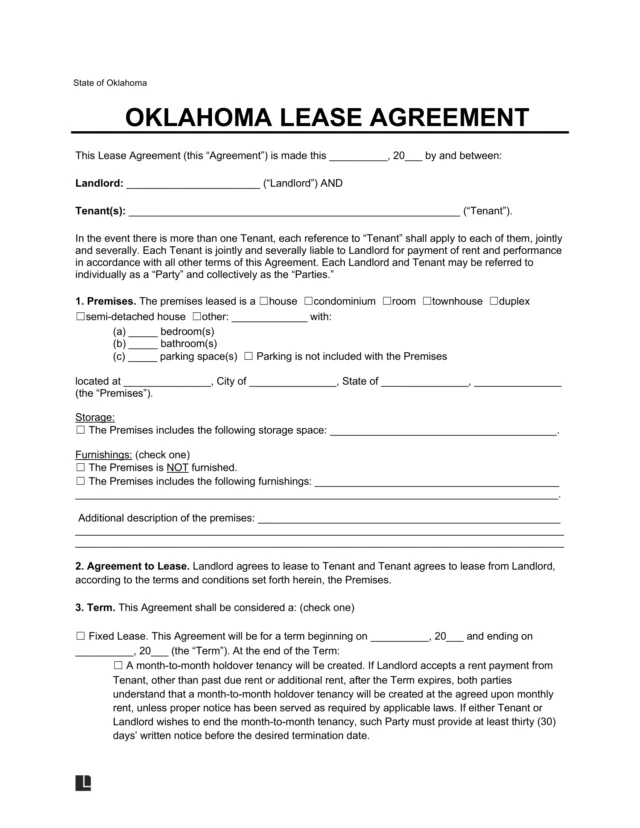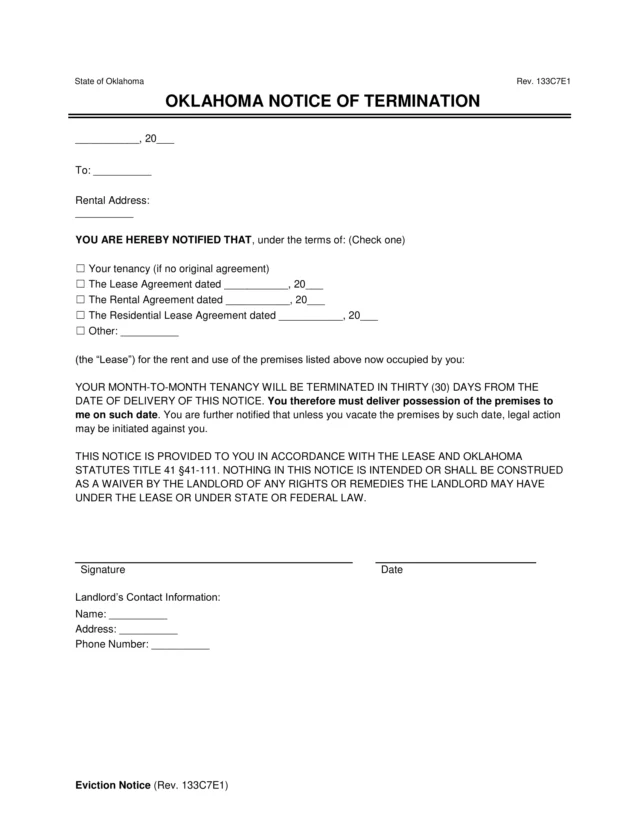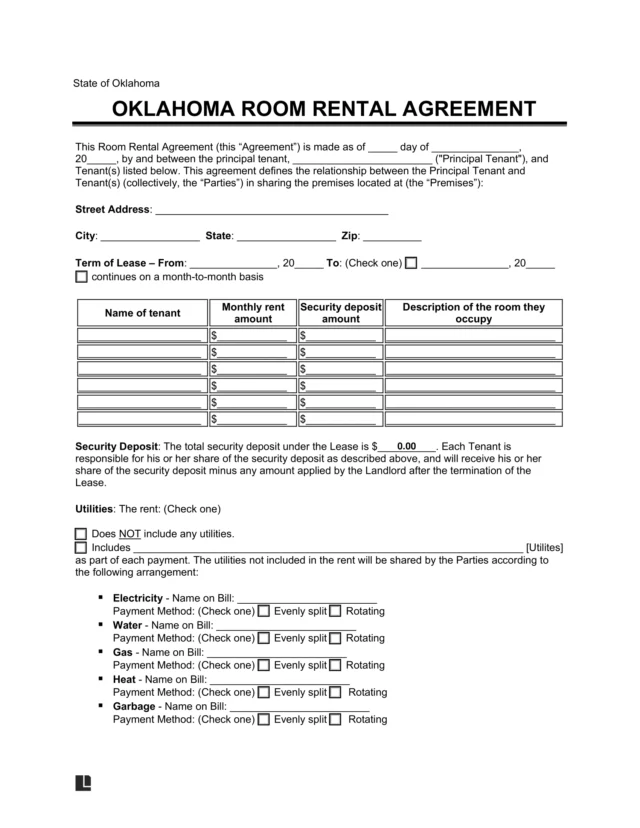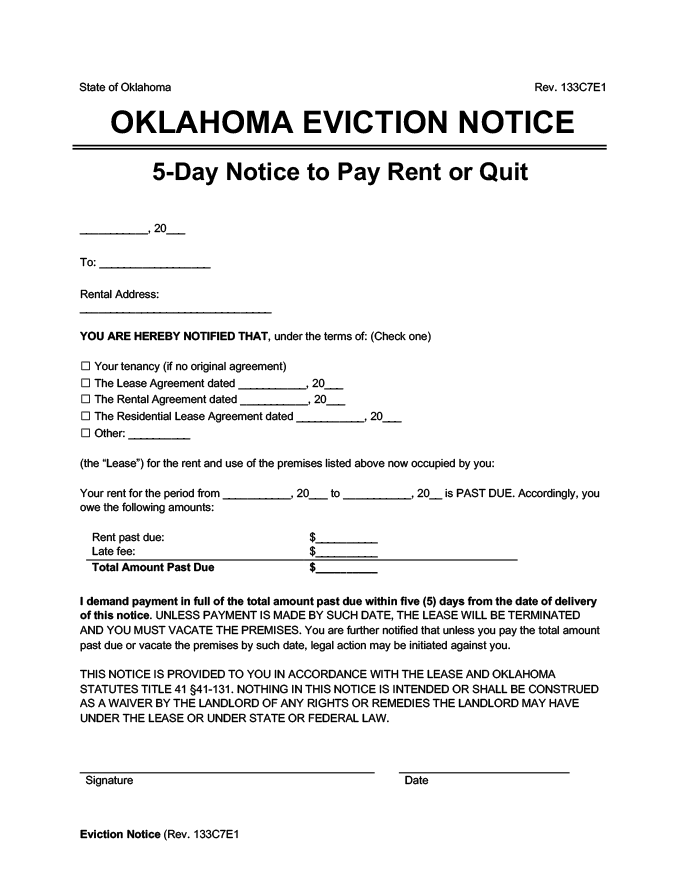Understanding Eviction Notices in Oklahoma
Oklahoma law requires landlords to give tenants a written notice before filing for eviction. The notice content depends on the reason, whether overdue rent, lease breaches, or ending the agreement.
Write your Oklahoma eviction notice using our document editor. When you’re ready, download it in PDF or Word format.
Types of Eviction Notices in Oklahoma
Oklahoma recognizes distinct eviction notices based on the underlying reason, ranging from nonpayment to lease violations, with legally defined timeframes.
5-Day Notice to Pay or Quit
In Oklahoma, if a tenant doesn’t pay rent, you can give them a 5-day notice to pay or quit. This notice informs the tenant that they have five days to pay the overdue rent or move out. According to 41 O.S. § 131, if the tenant doesn’t pay within those five days, you can end the lease and start the eviction process without sending another notice.
5-Day Notice to Pay Rent or Quit
Evict a tenant if they have overdue rent.
15-Day Notice to Quit for Non-Compliance
Send this form to tenants who have violated the lease terms. According to 41 O.S. § 132 (B), tenants have 10 days to rectify breaches and 15 days to vacate the property. State law outlines certain instances where immediate eviction is allowed, such as those that pose a threat to health and safety.
15-Day Notice to Quit for Non-Compliance
Begin evicting a tenant if they’ve broken the terms of your lease.
30-Day Notice Lease Termination
41 O.S. § 111 demands that landlords issue at least 30 days’ notice before ending a month-to-month lease. You don’t have to justify the termination, but ensure you don’t give a discriminatory reason if you decide to explain why you’re ending the lease.
30-Day Notice Lease Termination
End a month-to-month lease with 30 days' notice.
How to Evict a Tenant in Oklahoma
In Oklahoma, eviction lawsuits are governed by Title 12 § 1148.1 through 1148.16 of the Oklahoma Statutes.
Step 1: Provide Written Notice
Suppose a landlord wants to evict a tenant in Oklahoma. In that case, they must first provide written notice to the tenant, which states the potential reason(s) for eviction: non-payment of rent, non-compliance, or termination of a month-to-month tenancy. No notice is required before filing for eviction if the tenant poses a threat to other tenants or the property.
Step 2: File for Eviction
If the tenant fails to respond by the required time and remains on the property, the landlord files a Forcible Entry and Detainer (eviction) action in the local court where the property is located.
Landlords must state why they want the tenant to move out in the eviction complaint and provide them with a copy of the initial written eviction notice. A landlord can request damages in this action (overdue rent or repair costs, court costs, attorney fees, etc.). Still, he can only collect monetary damages if they notified the tenant of why they’re evicting them via Certified Mail and posted a copy on their door.
The court will set a date for the hearing and return on that date to plead your case to the judge.
Step 3: Serve the Tenant
A Deputy Sheriff will serve the tenant the summons once the landlord has filed the eviction with the court.
Step 4: File an Execution
If the court rules in the landlord’s favor and grants them possession of their property, they then must file an execution. After filing, a Deputy Sheriff will post the Eviction Notice at the property.
State Law requires a minimum of 48 hours to be given to the tenant(s) before removal. A date and time will be set to complete the eviction. At the time of eviction, the landlord must meet with the Deputy Sheriff, who will help take physical control of the property. The Deputy Sheriff will remove tenants still on the property at that time.
Related Court Forms
- Forcible Entry and Detainer Petition: The landlord or lawyer must complete the complaint and include the reason(s) for eviction.
- Forcible Entry and Detainer Summons: Notifies the tenant that they are being sued and provides information on the court date and how to plead their case in court.

